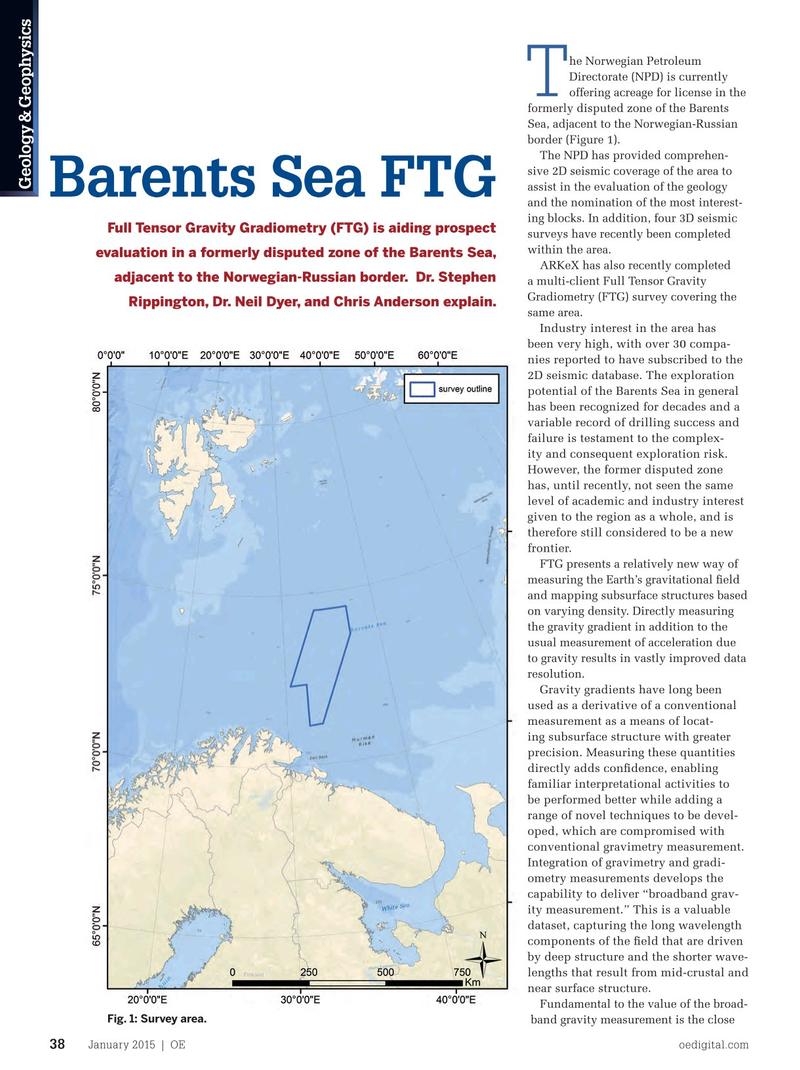
Page 36: of Offshore Engineer Magazine (Jan/Feb 2015)
Read this page in Pdf, Flash or Html5 edition of Jan/Feb 2015 Offshore Engineer Magazine
Figure 1 Survey area.
Figure 3 Measuring the full tensor.
he Norwegian Petroleum relationship between density
Directorate (NPD) is currently and seismic velocity. The two
T offering acreage for license in the properties can be modeled formerly disputed zone of the Barents in most circumstances with
Sea, adjacent to the Norwegian-Russian a common structure, allow- border (Figure 1). ing the two datasets to be
The NPD has provided comprehen- interpreted cooperatively. sive 2D seismic coverage of the area to This gives the gravity mea-
Geology & Geophysics assist in the evaluation of the geology surement direct relevance
Barents Sea FTG and the nomination of the most interest- to the work of the seismic ing blocks. In addition, four 3D seismic interpreter.
Full Tensor Gravity Gradiometry (FTG) is aiding prospect surveys have recently been completed ARKeX deploys the within the area. Lockheed Martin Full Tensor evaluation in a formerly disputed zone of the Barents Sea,
ARKeX has also recently completed Gravity Gradiometer, which adjacent to the Norwegian-Russian border. Dr. Stephen a multi-client Full Tensor Gravity not only delivers the vertical
Gradiometry (FTG) survey covering the gravity gradient, but the hori-
Rippington, Dr. Neil Dyer, and Chris Anderson explain. same area. zontal components (Gxx and
Industry interest in the area has
Gyy), as well as providing been very high, with over 30 compa- the full-tensor 3D measure- nies reported to have subscribed to the ment of the gravity feld. 2D seismic database. The exploration
The full tensor measure- potential of the Barents Sea in general ment adds resilience to the has been recognized for decades and a dataset, enabling the accurate variable record of drilling success and construction not only of the failure is testament to the complex- gradient tensor but of a large ity and consequent exploration risk. range of special functions, which may be
However, the former disputed zone used to automate interpretive operations has, until recently, not seen the same such as edge detection.
level of academic and industry interest
Interpreting FTG data given to the region as a whole, and is from the SE Barents Sea therefore still considered to be a new
The Barents Shelf is a complex tectonic frontier.
FTG presents a relatively new way of mosaic of cratons, platforms and basins, measuring the Earth’s gravitational feld which amalgamated and deformed and mapping subsurface structures based through a combination of compressional on varying density. Directly measuring and extensional tectonic phases. The the gravity gradient in addition to the SE Barents survey area lies in a position usual measurement of acceleration due where several important structural trends to gravity results in vastly improved data coalesce. Understanding the complex resolution. structural geology, at depth and in the
Gravity gradients have long been shallow section, is crucial for under- used as a derivative of a conventional standing the regional tectonic framework, measurement as a means of locat- basin development and prospect-scale ing subsurface structure with greater risks.
FTG data can be incorporated as part precision. Measuring these quantities of a multi-physics approach to mea- directly adds confdence, enabling sure, map, integrate and interpret in familiar interpretational activities to context with seismic and other data. be performed better while adding a
The combination of independent data range of novel techniques to be devel- provides additional constraints, which oped, which are compromised with inform and improve the resulting Earth conventional gravimetry measurement.
Integration of gravimetry and gradi- model. The ARKeX SE Barents FTG ometry measurements develops the
Survey was acquired in 2013 and 2014. capability to deliver “broadband grav-
The processed data became available in ity measurement.” This is a valuable
October 2014, after which a preliminary dataset, capturing the long wavelength interpretation was produced to place components of the feld that are driven the FTG data in a regional geological by deep structure and the shorter wave- context and to demonstrate how the lengths that result from mid-crustal and data can be integrated with other explo- ration datasets.
near surface structure.
Fundamental to the value of the broad- The area of interest contains elements
Fig. 1: Survey area.
band gravity measurement is the close of the Finnmark Platform, Tiddlybanken
January 2015 | OE oedigital.com 38 038_OE0115_G&G2_Arkex.indd 38 12/22/14 9:58 PM

 35
35

 37
37